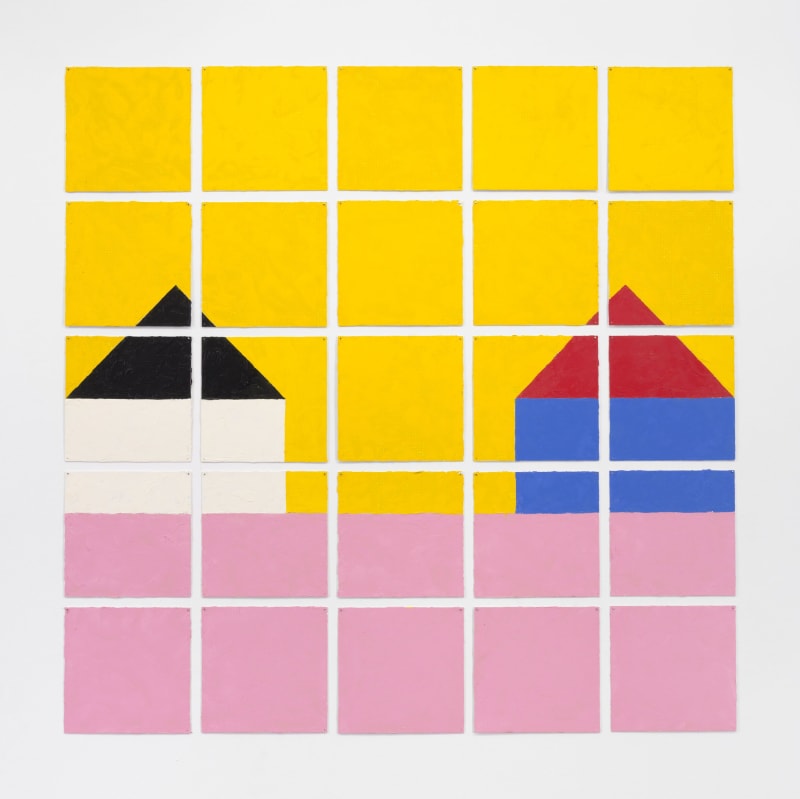On November 7, Marianne Boesky Gallery will open The House was Quiet and the World was Calm: Jennifer Bartlett 1970 – 2014, marking the gallery’s first solo presentation of the acclaimed artist’s work since it began representing her in fall 2018. The image of the archetypal house has permeated Bartlett’s work across media since the 1970s, encapsulating within its recognizable form both simple geometry and poignant symbolism. Through a selection of paintings and mixed-media installations, the upcoming exhibition captures Bartlett’s multifaceted and conceptually rigorous examinations of the idea of the house. The House was Quiet and the World was Calm will be on view at the gallery’s 509 W. 24th Street location through December 21, 2019.
Bartlett first came to prominence with the large-scale installation, Rhapsody, which debuted at Paula Cooper Gallery in 1976. It has subsequently been presented on three separate occasions at the Museum of Modern Art, which holds it as part of its collection. Rhapsody features 987 steel plates arranged on the wall in sections dedicated to colors, shapes, and lines, as well as forms like the house and tree. Bartlett envisioned the sprawling grid as a systematic examination of the breadth of formal tendencies within the painting genre. With each painted plate acting as both an autonomous work and a part of the greater whole, Rhapsody redefined the conceptual possibilities of painting and its relationship to monumental installation, positioning Bartlett as a visionary force. At the same time, Rhapsody captured Bartlett’s innate ability to fuse minimalist vocabulary with expressive gesture—a formal approach that would characterize her work throughout her career.
Bartlett began examining the simple motif of the house, though, even before the presentation of Rhapsody brought her acclaim. For Bartlett, the appeal of the house lies, in part, in its incredible universality. The simple square crowned with a triangle conjures an expansive array of emotions, memories, and associations across the spectrum of individuals. And in the U.S., it holds a particular place in the national psyche—a symbol of the deeply entrenched notion of the American dream. Subjected to Bartlett’s ongoing and systematic explorations of painting and printing techniques, however, the house in instances is flattened, reformulated, and distorted to a range of formal and emotional effects.
In House: Hatches (c. 1970-74), featured in the upcoming show, the house emerges amidst an aggressive tumult of hatch lines. The perspective slightly askew, the house appears as though it is warped—crushed by or being swept into the surrounding atmosphere. Here, Bartlett’s uncanny ability to use a simple technique, foundational to drawing, to evoke an emotional response is on full display, as the aggressive lines threaten our sensibilities around hearth and home. The unexpected infusion of emotion is equally present in Houses: Thin Lines (1998). At first glance, the installation appears as a purely formal experiment—36 steel plates, each painted with hand-lined grids and bisected diagonally with thin lines of yellow, green, and red. As one moves further from the wall, however, a series of houses, at varying scales, appears across the plates, transforming the work into a desolate and melancholy landscape.
The emergence of the house from seemingly abstract fields, whether produced through lines, dots, geometric forms, or swaths of color, is a constant in Bartlett’s work of the late 1990s. This approach is represented in the upcoming exhibition with Large House: Dots (1998), 3-D House, Grid (1998-99), Forest and Houses (1999), and Glass House on Plate (1999-2000). Together, these works highlight Bartlett’s ongoing engagement with the grid and the unexpected opportunities it offers to express a psychology of mood. In this way, Bartlett’s practice has consistently pushed and melded the boundaries between the emotionality of Abstract Expressionism and the subsequent rigidity of Minimalism.
In the 2000s, some of Bartlett’s work took a more directly expressive turn, as she produced richly layered oil paintings of the views around her home in Long Island. This work is represented in the exhibition by Amagansett Diptych #3, which captures two side-by-side views of her home on the beach. Moody and bursting with unspoken narrative, the paintings encapsulate Bartlett’s ability to both leverage and break free from her self-imposed grid systems. Together, the works in The House was Quiet and the World was Calm: Jennifer Bartlett 1970 – 2014 engage viewers in the incredible depth and intricacy of Bartlett’s practice, through her intense exploration of a single theme.
Jennifer Bartlett’s first survey exhibition was held in 1985 and traveled to the Walker Art Center, MN; the Brooklyn Museum, NY; and the Museum of Art, Carnegie Institute, PA, among others. In 2006, the Addison Gallery of American Art surveyed Bartlett’s early enameled steel plate paintings in the period from 1968–76. In 2013–14, Klaus Ottmann curated her second traveling survey Jennifer Bartlett: History of the Universe—Works 1970–2011, which visited the Pennsylvania Academy of the Fine Arts, PA and the Parrish Art Museum, NY. In 2014, the Cleveland Museum of Art united her three monumental plate pieces, Rhapsody, Song, and Recitative in the exhibition Epic Systems. Bartlett’s works are represented in the collections of the Dallas Museum of Fine Arts, TX; the Los Angeles County Museum of Art, CA; the Metropolitan Museum of Art, NY; the Museum of Fine Arts, Houston, TX; the Museum of Modern Art, NY; the Philadelphia Museum of Art, PA; the San Francisco Museum of Modern Art, CA; the Tate Modern, London; and the Whitney Museum of American Art, NY, among many others. Born in Long Beach, California, Bartlett studied at Mills College in California and received her MFA from Yale University in 1965. Bartlett is represented jointly by Marianne Boesky Gallery and Paula Cooper Gallery. She currently lives and works in Amagansett, NY.


